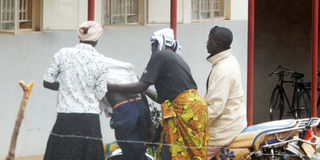A year later, Goli Health Centre IV still waiting for an ambulance

Affected. Women help a patient who was transported on a motorcycle to Goli Health Centre IV. PHOTO BY FELIX WAROM OKELLO.
What you need to know:
- About 15 to 20 pregnant women undergo caesarian operation monthly. The facility is managed by Uganda Protestant Medical Bureau with an aim of extending health services at subsidised costs to the nearby communities.
Nebbi. At Goli Health Centre IV, which is eight kilometres from Nebbi hospital, patients keep trickling in with some being carried on motorcycles and others on bicycles.
Motorcycles and bicycles have become the only means of transport for those living near and far off from Goli Health Centre IV as they endure potholes on the road in quest of healthcare.
However, the cost of hiring private transport is exorbitant for the poor communities.
Ms Majuma Munguryek of Vuli village in Paidha Town Council, Zombo District, who travelled about six kilometres seeking treatment, laments how some patients die on the way due to poor means of transport.
“Since I was admitted here (Goli), people have been hiring a car for a short distance at Shs30,000, from here to Nebbi hospital. Then Goli to Angal Hospital at Shs50,000. If the condition is not bad, we use boda boda,” Ms Munguryek explains.
Ms Munguryek wishes the health centre had an ambulance, saying it would save many lives and make referrals easy.
Goli Health Centre IV also serves people from the neighbouring Democratic Republic of Congo.
The officer-in-charge of Goli Health Centre IV, Dr Robert Paco, said: “We always advise our patients to look for private means such as motorcycles or cars when cases of referral arise given that we don’t have a stand-by ambulance at the moment.”
“The pain is more on the emergency cases and expectant mothers because many of them are transported on motorcycles, which is very risky,” he added.
Given the dire need to own an ambulance, the hospital management run by a church, paid $26,850 (about Shs100m) to Wamuco Motors Uganda Limited to supply an ambulance in March 2018. But to date, the ambulance has not been delivered by the company. In a bid to recover its money, the hospital management through Odongo & Co. Advocates, has written to Wamuco Motors, demanding to know why the ambulance has not been delivered.
“In March 2018, you (Wamuco) agreed to supply our client with a Land Cruiser Ambulance and assorted spare parts at an agreed total price of $26,850 which our client duly paid on March 21. Since then, you have not delivered the consignment albeit repeated verbal reminders and demands by our client and the diocesan legal adviser, Mr Rogers Kinobe,” the letter written by the lawyers reads in part.
Contractor speaks out
“Reason whereof, we demand that unless you refund the above sum plus 15 per cent monthly interest from the date of payment, our further instruction is to institute criminal and or civil suit against you jointly and severally,” they add.
But Mr Martin Musinguzi, the public relations officer for Wamuco Motors Company Limited, said: “At least 80 per cent of the supply is assured and the vehicle will be in Uganda within 10 days.”
Mr Musinguzi attributed the delay to deliver the ambulance to the first people whom they contracted for supplies.
“We have written to Goli Health Centre IV explaining the delay in supply of the ambulance,” he said.
One of the conditions set by the Health ministry to upgrade a health centre III to IV is to equip it with an ambulance, theatre room and recruit enough doctors to handle cases.
In 2015, President Museveni, at the wedding ceremony of Mr Allan Kajik and Ms Evelyn Anite, the minister of State for Investment, pledged to donate a new ambulance to Goli Health Centre IV, but to date, it has not been delivered.
About Goli
Goli Health Centre IV is overwhelmed with monthly enrolment of 8,000 in-patients and 12,000 out-patients.
About 15 to 20 pregnant women undergo caesarian operation monthly. The facility is managed by Uganda Protestant Medical Bureau with an aim of extending health services at subsidised costs to the nearby communities.




